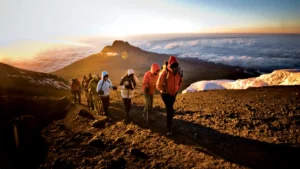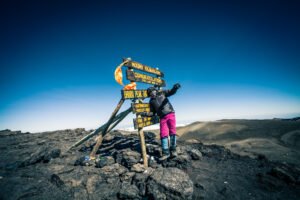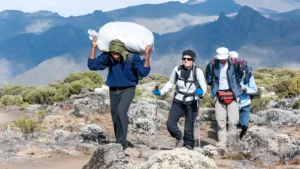We deliver responsible, sustainable tourism
The Best Expert Guide on Kilimanjaro
Home » How Long Days does it take to Climb Kilimanjaro
Rating:
Climbing Mount Kilimanjaro, Africa’s highest peak, takes between 5 and 9 days from start to finish, including both the ascent to Uhuru Peak and descent to the gate. How long it takes to climb Kilimanjaro depends heavily on your chosen route, your preparation, and most importantly, the time you allow for proper acclimatization. Proper planning focused on how long does it take to climb Kilimanjaro is crucial for a successful summit experience.

Climbers trekking on Mount Kilimanjaro’s Machame Route during sunrise
The most common reason climbers fail to reach Kilimanjaro’s summit is insufficient acclimatization time. As you climb higher, oxygen levels decrease, and your body needs time to adjust. Unlike technical mountains, Kilimanjaro is a “walk-up” climb where success depends mainly on your body’s ability to adapt to altitude.
On a 5-day climb, only about 27% of climbers reach the summit.
In contrast, 8-day climbs have success rates as high as 85%.
Clearly, rushing reduces your chances and increases the risk of altitude sickness.
Kilimanjaro offers six main routes, each with different durations that influence how long does it take to climb Kilimanjaro safely:
The Kilimanjaro National Park Authority (KINAPA) established minimum route durations based on what was initially considered safe for most hikers. However, experience over time has shown that these minimums are often too short. In reality, most climbers need additional days to acclimatize properly.
According to the International Climbing and Mountaineering Federation (UIAA), spending at least seven days on the mountain is ideal for a safe and enjoyable trek.
The table below lists each route’s distance, minimum, and recommended duration. Please note that the distance of the same route may vary due to different starting points.
| Route | Duration (Days) | Distance (km) | Notes |
|---|---|---|---|
| Marangu | 5-6 | 72 km / 45 mi | Short, less acclimatization |
| Umbwe | 6 | 53 km / 33 mi | Shortest, most challenging |
| Rongai | 6-7 | 74 km / 46 mi | Longer, better acclimatization |
| Machame | 6-7 | 62 km / 39 mi | Popular, moderate difficulty |
| Lemosho | 7-9 | 70 km / 43 mi | Longer route, excellent acclimatization |
| Northern Circuit | 8-9 | 98 km / 61 mi | Longest, highest success rates |
Shorter routes may appeal to climbers with limited time or budget but offer less acclimatization and lower summit success. Longer routes increase your acclimatization time, improve your chances of reaching the summit, and provide more scenic variety.
Most experienced guides recommend 7 to 8 days for the best balance of safety and summit success. Here’s why choosing the right Kilimanjaro climbing time is important:
Summiting success rates increase to 85-95%
Risk of altitude sickness significantly decreases
More time to appreciate the mountain’s unique environment
Better physical recovery between hiking days
Increased overall safety margin
Consider shorter routes only if you have recent high-altitude experience, pre-acclimatization, or extensive climbing history above 18,000 feet. Otherwise, investing in longer climbs pays off.

Understanding the daily hiking routine can help you prepare for how long it takes to climb Kilimanjaro effectively:
Regular hiking days: 4-7 hours
Summit day: Start around midnight, 6-8 hours to reach Uhuru Peak
Descent: Usually 2 days (about 5 hours to camp, then 4-6 hours to the gate)
Summit day is the toughest, often requiring climbing in the dark to reach the peak by sunrise. Knowing this helps you plan and manage your energy.
While good fitness makes daily hiking easier, it does not protect you from altitude sickness or determine how long it takes to climb Kilimanjaro successfully. According to altitude medicine experts, acclimatization is the critical factor. In fact, very fit climbers sometimes push through symptoms, increasing their risk of serious altitude problems.
While Kilimanjaro doesn’t require technical climbing skills, the trails are rugged, and daily hikes between camps can cover 7 to 9 kilometers (4 to 6 miles). Good fitness is essential. Less experienced hikers should choose longer programs to allow for more rest and recovery.
A reasonable level of fitness is required to climb Kilimanjaro successfully. If you are an inexperienced hiker, it is worth undertaking a training schedule, building to a point where you’re comfortable hiking for around five hours in hilly terrain. Ideally, use the training hikes to break in the boots and get used to the day pack you will take on the mountain. Running and cycling will help increase your aerobic fitness too.
If you’ve recently spent a few days above 4,000 meters (13,120 feet) within the last three months, you can consider shorter 5- or 6-day climbing programs. However, Kilimanjaro is not just about reaching the summit. It’s a chance to explore one of East Africa’s most unique environments — home to rare birds, wildlife, and extraordinary flora like Dendrosenecio kilimanjari. Choosing a 7- or 8-day program gives you the time to enjoy the journey, not just the destination. You’ll gain a deeper understanding of the mountain’s rich ecosystem and have more time to connect with your guides and fellow climbers.
Some climbers arrive in top physical condition, confident in their ability to summit quickly. But on Kilimanjaro, strength alone isn’t enough. Altitude affects everyone differently, and acclimatization is key. Even elite athletes can fall ill if they ascend too fast.
If you’re aiming for a shorter climb, consider first tackling Mount Meru. Located just 80 kilometers (50 miles) from Kilimanjaro and standing at 4,566 meters (14,980 feet), it’s an excellent option for pre-acclimatization.
Weather conditions on Kilimanjaro vary considerably with the seasons. Sub-zero nocturnal temperatures and high winds are likely at all times of year, but it is far preferable to climb in dry conditions. For this reason, January to March or July to October are far better for hiking than the rainy seasons of April to June and November to December. Should other factors force you to schedule a climb in the rainy season, try the Rongai Route, the only one that sticks to the dryer northern slopes


Shorter climbs cost less upfront. However, consider these questions when deciding how long to climb Kilimanjaro:
Would you regret turning back early due to altitude sickness?
Is saving money worth risking your health and summit dreams?
Would spending extra days increase your summit chances?
Most climbers find that spending more on longer routes improves their overall experience and summit success.
It takes around two days to descend Kilimanjaro from the Uhuru Peak Summit to the Finish point. The descent can take up to 5hrs to reach to Camp for overnight and the following day 4hrs to 6 hrs depending on the route and trekkers experience.
Elite athletes have completed Kilimanjaro at remarkable speeds, but these are exceptions, not the norm:
Fastest overall: 4 hours 56 minutes
Fastest woman: 6 hours 52 minutes
Fastest unaided: 9 hours 19 minutes
These feats come after intense pre-acclimatization and training.
To maximize your safety and summit success, plan for a 7-8 day climb with gradual acclimatization. The mountain will be there when you return, but your chance to summit safely is precious. Remember, investing extra days for proper acclimatization rewards you with higher success rates, reduced altitude sickness risk, and unforgettable memories on the Roof of Africa.
Hiking Kilimanjaro is a leading adventure company specializing in safe, guided climbs to the summit of Mount Kilimanjaro, offering expert guides and unforgettable trekking experiences.